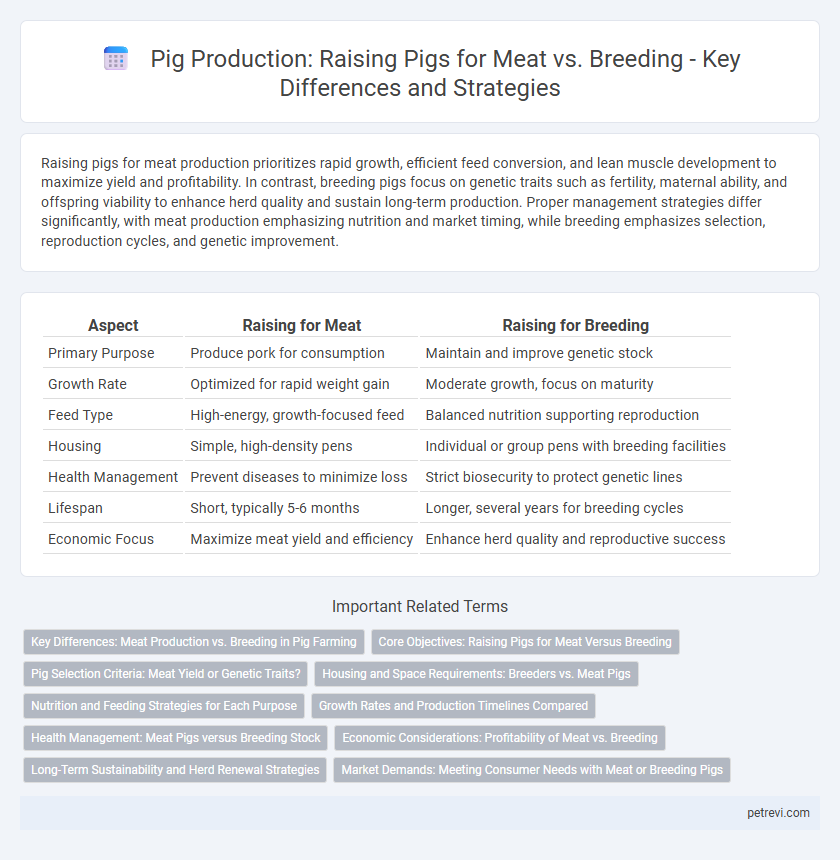Raising pigs for meat production prioritizes rapid growth, efficient feed conversion, and lean muscle development to maximize yield and profitability. In contrast, breeding pigs focus on genetic traits such as fertility, maternal ability, and offspring viability to enhance herd quality and sustain long-term production. Proper management strategies differ significantly, with meat production emphasizing nutrition and market timing, while breeding emphasizes selection, reproduction cycles, and genetic improvement.
Table of Comparison
| Aspect | Raising for Meat | Raising for Breeding |
|---|---|---|
| Primary Purpose | Produce pork for consumption | Maintain and improve genetic stock |
| Growth Rate | Optimized for rapid weight gain | Moderate growth, focus on maturity |
| Feed Type | High-energy, growth-focused feed | Balanced nutrition supporting reproduction |
| Housing | Simple, high-density pens | Individual or group pens with breeding facilities |
| Health Management | Prevent diseases to minimize loss | Strict biosecurity to protect genetic lines |
| Lifespan | Short, typically 5-6 months | Longer, several years for breeding cycles |
| Economic Focus | Maximize meat yield and efficiency | Enhance herd quality and reproductive success |
Key Differences: Meat Production vs. Breeding in Pig Farming
Raising pigs for meat production prioritizes rapid growth rates, feed efficiency, and carcass quality, with breeds selected for lean muscle and high yield. In contrast, pig breeding focuses on reproductive traits such as fertility, litter size, and genetic diversity to improve herd quality over generations. Meat production pigs undergo shorter growth cycles, while breeding stock requires longer life spans and meticulous health management to sustain genetic lines.
Core Objectives: Raising Pigs for Meat Versus Breeding
Raising pigs for meat prioritizes maximizing growth rates, feed conversion efficiency, and carcass quality to meet market demand for pork products. In contrast, raising pigs for breeding focuses on genetic traits such as reproductive performance, sow longevity, and piglet vitality to improve herd productivity over generations. Both approaches require tailored management practices to align with their core objectives, ensuring optimal outcomes in pig production systems.
Pig Selection Criteria: Meat Yield or Genetic Traits?
Raising pigs for meat prioritizes selection criteria such as growth rate, feed efficiency, and carcass quality to maximize meat yield and market value. In contrast, raising pigs for breeding emphasizes genetic traits including fertility, disease resistance, and lineage to enhance long-term herd improvement and reproductive performance. Effective pig production balances these objectives by aligning selection strategies with the specific production purpose, ensuring optimal economic returns and sustainable herd development.
Housing and Space Requirements: Breeders vs. Meat Pigs
Breeding pigs require more spacious and specialized housing to accommodate gestation stalls, farrowing crates, and nursery pens, ensuring proper care during reproduction and piglet development. Meat pigs benefit from more open, higher-density housing systems optimized for growth efficiency and feed conversion rates, often employing group housing with ample space for exercise and movement. Proper ventilation and hygiene are critical in both settings but must be tailored to the distinct stress and health management needs of breeders versus meat pigs.
Nutrition and Feeding Strategies for Each Purpose
Raising pigs for meat requires high-energy diets rich in carbohydrates and proteins to promote rapid growth and muscle development, with balanced vitamins and minerals to support metabolism and immune function. In contrast, pigs raised for breeding benefit from diets enhanced with higher levels of vitamins A, D, and E, along with calcium and phosphorus, to optimize reproductive performance and sow longevity. Tailored feeding strategies incorporating phase feeding and nutrient-dense feed formulations help maximize feed efficiency and meet the distinct physiological demands of meat production versus breeding stock maintenance.
Growth Rates and Production Timelines Compared
Raising pigs for meat prioritizes faster growth rates, typically reaching market weight between 5 to 7 months, optimizing feed efficiency and reducing production timelines. In contrast, breeding pigs are selected for reproductive traits and longevity, resulting in slower growth but extended productive lifespan to maximize litter output over multiple parities. Meat-focused pig production emphasizes quick turnover, while breeding stock management balances growth with reproductive performance to sustain herd genetics.
Health Management: Meat Pigs versus Breeding Stock
Health management for meat pigs prioritizes rapid growth and disease prevention through controlled nutrition, vaccination, and biosecurity measures to optimize weight gain and meat quality. In contrast, breeding stock requires rigorous health monitoring, reproductive health assessments, and genetic disease screening to ensure fertility, longevity, and the transmission of desirable traits. Both approaches demand tailored veterinary care protocols, but breeding stock management emphasizes reproductive efficiency and long-term herd health sustainability.
Economic Considerations: Profitability of Meat vs. Breeding
Raising pigs for meat production generally yields higher immediate profitability due to faster turnover rates and market demand for pork products. Breeding pigs require greater investment in genetics and long-term maintenance, often resulting in delayed financial returns but enhanced herd quality and sustainability. Economic considerations favor meat production for short-term gains while breeding supports long-term business viability through improved stock and consistent supply.
Long-Term Sustainability and Herd Renewal Strategies
Raising pigs for breeding emphasizes long-term sustainability by ensuring continuous herd renewal through selective genetics and health monitoring, which enhances disease resistance and productivity over generations. In contrast, raising pigs solely for meat focuses on short-term growth rates and feed efficiency, often requiring frequent restocking and potentially leading to genetic dilution. Sustainable herd management integrates breeding programs with meat production goals to maintain genetic diversity and optimize lifetime productivity.
Market Demands: Meeting Consumer Needs with Meat or Breeding Pigs
Raising pigs for meat production focuses on fast growth rates, feed efficiency, and carcass quality to meet high market demand for pork products. In contrast, breeding pigs are selected based on genetic traits like reproductive performance, disease resistance, and longevity to sustain herd productivity. Consumer preferences drive the meat market, while breeding pig selection ensures long-term supply and genetic improvement in pig production.
Raising for Meat vs Raising for Breeding for Pig Production Purpose Infographic

 petrevi.com
petrevi.com